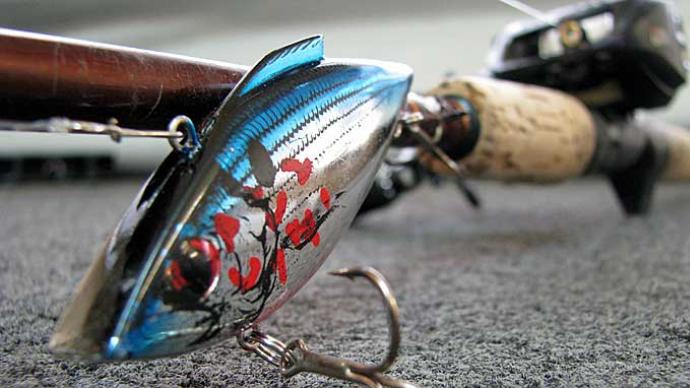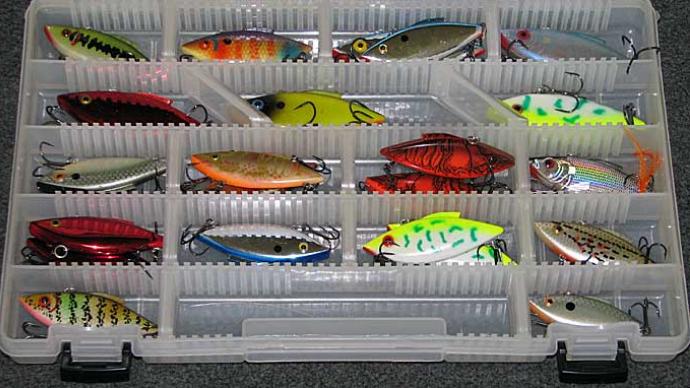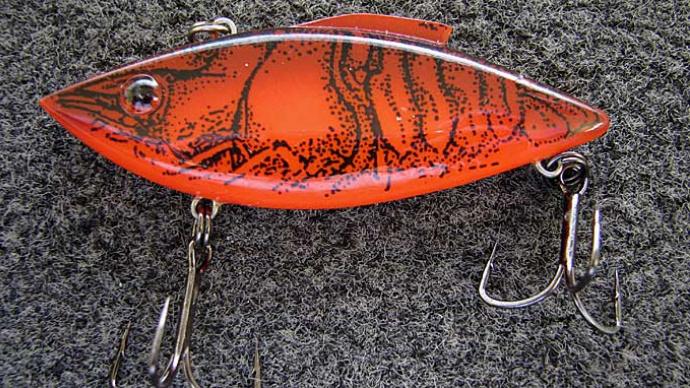Mike Siefert, an expert Arkansas guide, was sharing in Parts I, II, and III how to fish flat-sided rattle-baits in “the jungle”of his home lake - Lake Millwood. Having proved himself to be an expert with lipless crankbaits, we now take a close up look at Mike’s pro-staffer connect to Bill Lewis Lure Company, and some of the developments going on at Rat-L-Trap, including “Liv-N-Sound®” and the “Vibra-Trap™”.
Mike, you have had a long term connection with Rat-L-Trap… and we noticed a lot of your client pictures on your guide service website have Rat-L-Traps hanging from the mouths of some impressive bass.

“We catch a lot of fish on Rat-L-Traps. I have been very blessed to be a part of their pro-staff for almost 25 years and done a lot of work with them with experimental prototypes, and experimental hooks, and everything from the hook hangers and split rings, to colors, patterns, sizes and shapes. I have worked with Rat-L-Trap for a long time. I’ve known those guys down in Alexandria for years and years and they are a great group to work with.”
So how did your connection with Rat-L-Trap come about?
“Actually, it started back in the early 90’s or late 80’s, somewhere in there. I grew up fishing Lake Millwood with crankbaits. My dad was close friends with Cotton Cordell. (Legendary lure maker) And Cotton Cordell, from Hot Springs, had a son near the same age, Mike Cordell. And they would show up at our house at 3 or 4 o’clock in the morning for breakfast before a fishing trip. They’d throw a handful of Big O’s and other crankbaits on the table and say “Hey Doc, we’re gonna try these today. We just made em last night.”
“So we’d go to Millwood, or Lake Ouachita (pronounced Washita), or Toledo Bend, or Sam Rayburn and all these lakes in Arkansas, Louisiana, and Texas, and we’d fish with homemade crankbaits that Cotton Cordell and his family made at the kitchen table. I’ve still got those old hand-painted balsawood crankbaits – they might be worth something someday. I hardly ever take them out anymore, and they sure hold a lot of sentimental value and memories. But that’s what started me fishing crankbaits.”
“Over the years, Cotton Cordell eventually came out with lipless crankbait called a Hot Spot. And we fished a bunch of those. Of course, we all grow older, and go off to school, and start our own lives and families, so I kinda lost contact with the Cotton and Mike, though I still talk to them occasionally. But he sold that business to Pradco back in the late 80’s or early 90’s and they’re still making his original Big O cranks.”
“But when I bumped into Rat-L-Trap, I was actually working a tackle show with Cotton and Mike and the family, and I was eating dinner one night with one of the guys at Rat-L-Trap, and we started talk’in. And he said to me, ‘Ya know, that’s all we do is lipless crankbaits’, and I said ‘I’d sure like to try some of your Rat-L-Traps on Millwood.' He sent me a handful of them and boy did the fish respond. The rest is history, and I began working with them on a regular basis. And that’s kinda how it started back in the mid to late 70’s and early 80’s.”
“As I got to working closer with them and started using their Rat-L-Traps on a regular basis, that’s when I discovered Rat-L-Trap made a lot more different sizes, colors, patterns, and sounds than Cordell’s Hot Spot did. Over time I’ve just proven it to be the best lipless crankbait on the market. You can certainly pay a lot more for baits made over in China or Japan, but I don’t think they catch any more fish, and I don’t think they’ll catch any better quality than a Rat-L-Trap made right here in the United States. And in this day and age, with this economy, this is even more important in my opinion. Seems like everyone is going offshore or to Mexico to make stuff, but Rat-L-Traps are hand built right here, 100% in good ole’ USA.”
On the Rat-L-Trap website, (http://rat-l-trap.com) we noticed they were talking about the changes they have made in the sounds that their baits are making. And what was the term they were using…ah…“Liv-N-Sound®” Yes, talk to us about that.
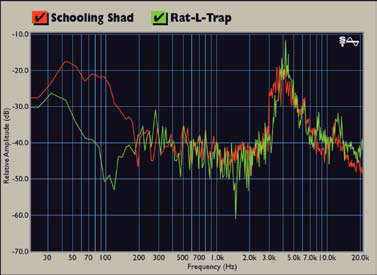
“They used to have a graph on their website as well as an MP3 clip that would give you the actual sound that schooling baitfish, or an injured or distressed baitfish makes underwater. And you could take that sound pattern and put it on a graph. Then you could take the sound pattern that the new Rat-L-Traps make when those beads are shaking in their hollow bodies. And you could almost identically, (frequency for frequency and wavelength for wavelength), superimpose one over the other. This remarkable sound improvement is in these “Liv-N-Sound®” baits.
“The folks at Rat-L-Trap worked a lot in the early days with Loren Hill, an ichthyologist and audiologist at the University of Oklahoma, and most recently with Joseph Olson, President of Cetacean Research, and with audiologists and wavelength/frequency engineers. And they worked to develop a bait that put out unique underwater sound waves that imitates the sound of real baitfish. Naturally these specific attract predator fish and stimulate an aggressive feeding response.”
And have you personally put the new baits up against the older models to see what happens?
“Oh yeah! I mean, like I said, I’ve got lots of old Rat-L-Traps from 20+ years ago, and some of these new prototypes of the new ones too. And… I’ve found the new baits do tend to catch more fish. That was part of our development process, to fish both models in simultaneous conditions to get any marked difference in response of the bass.”
And that’s not just hype? That’s absolute fact?
“Absolutely! And it may be due to a combination of things like the new scales, and the new color patterns, the new hooks, and the new prints that they’re putting on them – combining maybe all the above, with that new sound. But they definitely put more fish in the boat.”
“Most of the new baits that are coming out have the 'Liv-N-Sound®' in them. They’ve put in different size BB’s and using different density metals like Tungsten and others; for instance, they’ve installed a larger BB in the head, and smaller, more numerous BB’s in the middle of the body and near the tail. Now, don’t get me wrong, I can still take one of the older Traps, (some of my standby colors and favorites of the old days), and still catch lots of big fish on them. But I have found that the new Traps that have the 'Liv-N-Sound®' tend to catch more fish.”
It sounds more and more like natural forage, then?
“Natural prey. I think every little bit helps, and I know that baits with this new sound definitely have an advantage over the old ones. I mean, if you were to take one of the chrome blue ones that has the'Liv-N-Sound®' for example, and I take one of the old chrome blue ones from 20 years ago, and we’re fishing the same rods and the same line and the same reels and the same setup, you may out catch me 2 to 1.”
That noticeable?
“It’s definitely an improvement because of the sound that it produces.”
When you look at the simplicity of the lure from the outside, ignoring what’s on in the inside, your first impulse is to say “There can’t be that much more that they can do to a Rat-L-Trap.” But the company has been working on some new innovations?
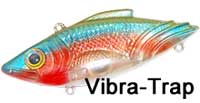
“Oh yeah, one of our improvements has only recently been released; it’s called a ‘Vibra-Trap™’. It’s on their website too.”
“And it’s got a totally different erratic retrieve, it’s got a different sound, it’s got a different drop rate, a different drop pattern – it kinda ‘sashays’ side to side rather than just a straight fall – it’s a totally different animal. I’ve got about two dozen of them I’ve been fishing with for a few years – fine-tuning them. They’re making both an aggressive version, and a subtle version. But it's completely innovative and like nothing that precedes it, like nothing else out there. And while it was tough getting it tuned just right, the wait was worth it, believe me!”
Are these the baits that don’t come back to the boat in a straight line, but have an irregular run to them?
“Yes, it’ll run to the left, and then run to the right, extremely erratic in its action, like nothing else you’ve ever seen, more like realistic fleeing prey.”
And it appears to have a little protruding belly, a dip in the nose, and some subtle design changes to the tail. Do these subtle changes make that huge a difference?
“Today, ‘Hydrodynamics’ makes a huge difference in how Rat-L-Trap designs a bait. A lot of engineering, (countless hours), was spent on the new design by computer model, design engineers, actual tank testing, and putting it in the hands of the pro-staff and letting us ‘tweak’ it.”
|
Image
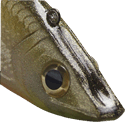
|
Image

|
Well, a lure company can’t sit still, can it? It’s such a competitive world out there now.
“Chuck, you are absolutely right! Rat-L-Trap has never been content with just sitting on something that’s been good for years. They work hard to keep improving it for the weekend fisherman or the next BassMaster Classic Tournament Winner. And they work tirelessly to keep the competitive angler ahead of the next guy. I won’t use anything else.”
--------------------------------------------------------------------------------------------------------------
In PART I, our Arkansas guide introduced us to Lake Millwood, the proper locations there for throwing lipless crankbaits, and how summer conditions position the fish. He shared basic Rat-L-Trap techniques for beginners, and helped us focus on presentation, including the importance of deflection. We then learned about the territorial habits of bigger fish, and the importance of stealth in catching them.
In PART II, our Arkansas guide continued to share with us the knowledge that is essential to fishing lipless crankbaits successfully. Including… the proper hookset, the fight, big bass and their territorial behavior, treble hooks and a way to test sharpness, what happens when hungry bass strike, the proper speed of the retrieve, and a mind blowing Rat-L-Trap presentation that was hard to believe.In PART III, Mike Siefert taught us about colors and patterns, discussed sizes, casting, scent usage, split-rings and speed-clips, line, rods, reels, and rod position. He showed us how to adjust to changing water levels, light conditions, and when to change up. Discussed were the unique challenges of working with pros, when to hire a guide, how success is in the details, and the power of confidence.
--------------------------------------------------------------------------------------------------------------
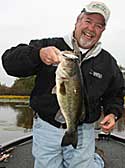
For more information about Lake Millwood and guide Mike Siefert, contact:
Millwood Lake Guide Service
P.O. Box 4957 Texarkana, TX
75505-4957
MillwoodLakeGSvc@aol.com
Telephone 870-772-6840
Mobile 903-277-3401


